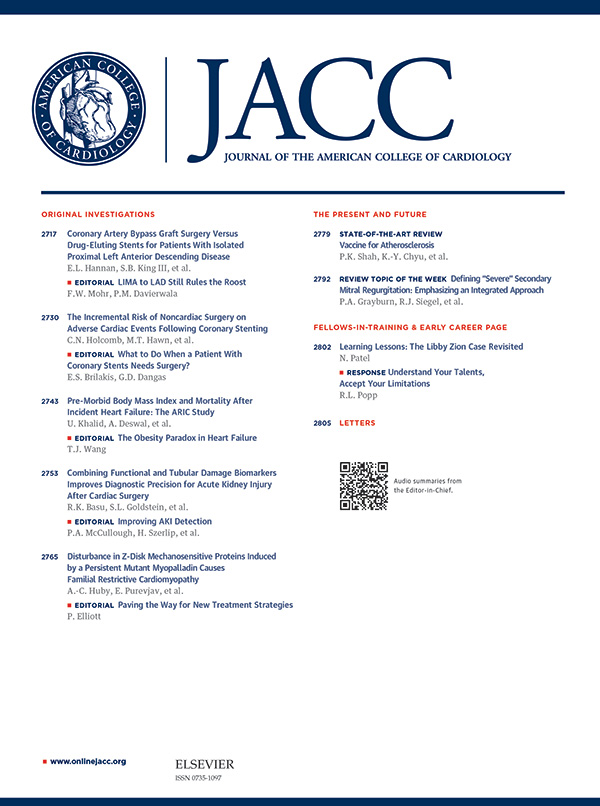Bioprosthetic vs Mechanical Aortic Valve Replacement in Patients 40-75 Years
IF 21.7
1区 医学
Q1 CARDIAC & CARDIOVASCULAR SYSTEMS
引用次数: 0
Abstract
Background
The choice of bioprosthetic or mechanical surgical aortic valve replacement (AVR) should balance individual valve durability with the potential liabilities of oral anticoagulation.Objective
To inform clinical practice, this study sought to evaluate contemporary, real-world, long-term AVR outcomes from the Society of Thoracic Surgeons Adult Cardiac Surgery Database (STS-ACSD).Methods
All patients undergoing primary isolated bioprosthetic or mechanical AVR were identified. Patients aged <40 and >75 years with endocarditis, emergency/salvage status, shock, ejection fraction ≤25%, and any prior cardiac surgery were excluded. Validated methodology was applied for linkage to the National Death Index to define longitudinal all-cause mortality (2008-2019). Robust risk adjustment was performed using age-specific inverse probability weighting and restricted cubic splines to model non-linear age relationships. Sensitivity analyses excluded pure aortic insufficiency, intermediate/high risk (STS >4%), and discontinued valve types.Results
A total of 109,842 patients underwent bioprosthetic (n=94,125) or mechanical (n=15,717) AVR during the study period. After risk adjustment, freedom from all-cause mortality favored mechanical valves to age 60. Age group-specific analyses demonstrated mechanical valves to be associated with lower all-cause mortality in all age groups ≤ 60 years. These results remained consistent across all sensitivity analyses.Conclusions
In patients 60 years of age or younger, mechanical AVR was associated with an independent risk-adjusted survival benefit compared to bioprosthetic AVR. These contemporary 12-year survival data further inform patient and provider shared clinical decision-making regarding prosthetic aortic valves.求助全文
约1分钟内获得全文
求助全文
来源期刊
CiteScore
42.70
自引率
3.30%
发文量
5097
审稿时长
2-4 weeks
期刊介绍:
The Journal of the American College of Cardiology (JACC) publishes peer-reviewed articles highlighting all aspects of cardiovascular disease, including original clinical studies, experimental investigations with clear clinical relevance, state-of-the-art papers and viewpoints.
Content Profile:
-Original Investigations
-JACC State-of-the-Art Reviews
-JACC Review Topics of the Week
-Guidelines & Clinical Documents
-JACC Guideline Comparisons
-JACC Scientific Expert Panels
-Cardiovascular Medicine & Society
-Editorial Comments (accompanying every Original Investigation)
-Research Letters
-Fellows-in-Training/Early Career Professional Pages
-Editor’s Pages from the Editor-in-Chief or other invited thought leaders

 求助内容:
求助内容: 应助结果提醒方式:
应助结果提醒方式:


